Graphene/PtSe2/Ultra-Thin SiO2/Si Broadband Photodetector with Large Responsivity and Fast Response Time
Abstract
1. Introduction
2. Experimental
2.1. Material Synthesis and Device Fabrication
2.2. Characterization
3. Results and Discussion
4. Conclusions
Supplementary Materials
Author Contributions
Funding
Data Availability Statement
Conflicts of Interest
References
- Pospischil, A.; Humer, M.; Furchi, M.M.; Bachmann, D.; Guider, R.; Fromherz, T.; Mueller, T. CMOS-compatible graphene photodetector covering all optical communication bands. Nat. Photonics 2013, 7, 892–896. [Google Scholar]
- Liu, S.; Ding, Y.; Wang, X.; Li, Y.; Chen, J.; Zhao, Z.; Zhu, Z. High Gain Derived from Facile Carrier Dynamics Manipulation for Sensitive X-ray Detection and Imaging. Adv. Electron. Mater. 2024, 10, 2300555. [Google Scholar] [CrossRef]
- Wang, H.; Li, Z.; Li, D.; Chen, P.; Pi, L.; Zhou, X.; Zhai, T. Van der Waals integration based on two-dimensional materials for high-performance infrared photodetectors. Adv. Funct. Mater. 2021, 31, 2103106. [Google Scholar] [CrossRef]
- Huang, Z.; Carey, J.E.; Liu, M.; Guo, X.; Mazur, E.; Campbell, J.C. Microstructured silicon photodetector. Appl. Phys. Lett. 2006, 89, 033506. [Google Scholar]
- Michel, J.; Liu, J.; Kimerling, L.C. High-performance Ge-on-Si photodetectors. Nat. Photonics 2010, 4, 527–534. [Google Scholar]
- Zhu, Q.; Ye, P.; Tang, Y.; Zhu, X.; Cheng, Z.; Xu, J.; Xu, M. High-performance broadband photoresponse of self-powered Mg2Si/Si photodetectors. Nanotechnology 2021, 33, 115202. [Google Scholar]
- Geng, X.; Wang, F.; Tian, H.; Feng, Q.; Zhang, H.; Liang, R.; Shen, Y.; Ju, Z.; Gou, G.-Y.; Deng, N. Ultrafast photodetector by integrating perovskite directly on silicon wafer. ACS Nano 2020, 14, 2860–2868. [Google Scholar]
- Chen, J.; Ouyang, W.; Yang, W.; He, J.H.; Fang, X. Recent progress of heterojunction ultraviolet photodetectors: Materials, integrations, and applications. Adv. Funct. Mater. 2020, 30, 1909909. [Google Scholar] [CrossRef]
- Wang, S.; Liu, X.; Xu, M.; Liu, L.; Yang, D.; Zhou, P. Two-dimensional devices and integration towards the silicon lines. Nat. Mater. 2022, 21, 1225–1239. [Google Scholar]
- Liu, C.; Guo, J.; Yu, L.; Li, J.; Zhang, M.; Li, H.; Shi, Y.; Dai, D. Silicon/2D-material photodetectors: From near-infrared to mid-infrared. Light Sci. Appl. 2021, 10, 123. [Google Scholar]
- Xu, M.; Liang, T.; Shi, M.; Chen, H. Graphene-like two-dimensional materials. Chem. Rev. 2013, 113, 3766–3798. [Google Scholar] [PubMed]
- Li, X.; Zhu, M.; Du, M.; Lv, Z.; Zhang, L.; Li, Y.; Yang, Y.; Yang, T.; Li, X.; Wang, K. High detectivity graphene-silicon heterojunction photodetector. Small 2016, 12, 595–601. [Google Scholar] [PubMed]
- Huang, L.; Dong, B.; Guo, X.; Chang, Y.; Chen, N.; Huang, X.; Liao, W.; Zhu, C.; Wang, H.; Lee, C. Waveguide-integrated black phosphorus photodetector for mid-infrared applications. ACS Nano 2018, 13, 913–921. [Google Scholar]
- Han, R.; Feng, S.; Sun, D.-M.; Cheng, H.-M. Properties and photodetector applications of two-dimensional black arsenic phosphorus and black phosphorus. Sci. China Inform. Sci. 2021, 64, 140402. [Google Scholar]
- Lan, C.; Li, C.; Ho, J.C.; Liu, Y. 2D WS2: From vapor phase synthesis to device applications. Adv. Electron. Mater. 2021, 7, 2000688. [Google Scholar]
- Xue, H.; Dai, Y.; Kim, W.; Wang, Y.; Bai, X.; Qi, M.; Halonen, K.; Lipsanen, H.; Sun, Z. High photoresponsivity and broadband photodetection with a band-engineered WSe2/SnSe2 heterostructure. Nanoscale 2019, 11, 3240–3247. [Google Scholar]
- Gant, P.; Huang, P.; de Lara, D.P.; Guo, D.; Frisenda, R.; Castellanos-Gomez, A. A strain tunable single-layer MoS2 photodetector. Mater. Today 2019, 27, 8–13. [Google Scholar]
- Yang, Y.; Li, J.; Choi, S.; Jeon, S.; Cho, J.H.; Lee, B.H.; Lee, S. High-responsivity PtSe2 photodetector enhanced by photogating effect. Appl. Phys. Lett. 2021, 118, 013103. [Google Scholar]
- Wang, G.; Wang, Z.; McEvoy, N.; Fan, P.; Blau, W.J. Layered PtSe2 for sensing, photonic, and (opto-) electronic applications. Adv. Mater. 2021, 33, 2004070. [Google Scholar] [CrossRef]
- Cao, B.; Ye, Z.; Yang, L.; Gou, L.; Wang, Z. Recent progress in van der Waals 2D PtSe2. Nanotechnology 2021, 32, 412001. [Google Scholar]
- Xu, H.; Guo, C.; Zhang, J.; Guo, W.; Kuo, C.N.; Lue, C.S.; Hu, W.; Wang, L.; Chen, G.; Politano, A. PtTe2-based type-II Dirac semimetal and its van der Waals heterostructure for sensitive room temperature terahertz photodetection. Small 2019, 15, 1903362. [Google Scholar] [CrossRef] [PubMed]
- Wu, D.; Zhao, Z.; Lu, W.; Rogée, L.; Zeng, L.; Lin, P.; Shi, Z.; Tian, Y.; Li, X.; Tsang, Y.H. Highly sensitive solar-blind deep ultraviolet photodetector based on graphene/PtSe2/β-Ga2O3 2D/3D Schottky junction with ultrafast speed. Nano Res. 2021, 14, 1973–1979. [Google Scholar] [CrossRef]
- Xie, C.; Zeng, L.; Zhang, Z.; Tsang, Y.-H.; Luo, L.; Lee, J.-H. High-performance broadband heterojunction photodetectors based on multilayered PtSe2 directly grown on a Si substrate. Nanoscale 2018, 10, 15285–15293. [Google Scholar] [PubMed]
- Ma, M.; Chen, H.; Zhou, K.; Xie, C.; Liang, Y.; Wang, L.; Wu, C.; Yang, W.; Guo, J.; Luo, L. Multilayered PtSe2/pyramid-Si heterostructure array with light confinement effect for high-performance photodetection, image sensing and light trajectory tracking applications. J. Mater. Chem. C 2021, 9, 2823–2832. [Google Scholar]
- Ye, P.; Xiao, H.; Zhu, Q.; Kong, Y.; Tang, Y.; Xu, M. Si-CMOS-compatible 2D PtSe2-based self-driven photodetector with ultrahigh responsivity and specific detectivity. Sci. China Mater. 2023, 66, 193–201. [Google Scholar]
- Jellison Jr, G. Examination of thin SiO2 films on Si using spectroscopic polarization modulation ellipsometry. J. Appl. Phys. 1991, 69, 7627–7634. [Google Scholar]
- Rao, G.; Wang, X.; Wang, Y.; Wangyang, P.; Yan, C.; Chu, J.; Xue, L.; Gong, C.; Huang, J.; Xiong, J. Two-dimensional heterostructure promoted infrared photodetection devices. InfoMat 2019, 1, 272–288. [Google Scholar]
- Zeng, L.; Han, W.; Wu, S.-E.; Wu, D.; Lau, S.P.; Tsang, Y.H. Graphene/PtSe2/pyramid Si Van der Waals schottky junction for room-temperature broadband infrared light detection. IEEE T. Electron Dev. 2022, 69, 6212–6216. [Google Scholar]
- Tong, Y.; Bouaziz, M.; Oughaddou, H.; Enriquez, H.; Chaouchi, K.; Nicolas, F.; Kubsky, S.; Esaulov, V.; Bendounan, A. Phase transition and thermal stability of epitaxial PtSe2 nanolayer on Pt(111). RSC Adv. 2020, 10, 30934–30943. [Google Scholar]
- Yin, S.; Zhang, W.; Tan, C.; Chen, L.; Chen, J.; Li, G.; Zhang, H.; Zhang, Y.; Wang, W.; Li, L. Thermal conductivity of few-layer PtS2 and PtSe2 obtained from optothermal Raman spectroscopy. J. Phys. Chem. C 2021, 125, 16129–16135. [Google Scholar]
- Li, X.; Cai, W.; An, J.; Kim, S.; Nah, J.; Yang, D.; Piner, R.; Velamakanni, A.; Jung, I.; Tutuc, E. Large-area synthesis of high-quality and uniform graphene films on copper foils. Science 2009, 324, 1312–1314. [Google Scholar] [CrossRef] [PubMed]
- Ni, Z.; Wang, Y.; Yu, T.; Shen, Z. Raman spectroscopy and imaging of graphene. Nano Res. 2008, 1, 273–291. [Google Scholar] [CrossRef]
- Lin, S.; Liu, Y.; Hu, Z.; Lu, W.; Mak, C.H.; Zeng, L.; Zhao, J.; Li, Y.; Yan, F.; Tsang, Y.H. Tunable active edge sites in PtSe2 films towards hydrogen evolution reaction. Nano Energy 2017, 42, 26–33. [Google Scholar] [CrossRef]
- Zeng, L.H.; Lin, S.H.; Li, Z.J.; Zhang, Z.X.; Zhang, T.F.; Xie, C.; Mak, C.H.; Chai, Y.; Lau, S.P.; Luo, L.B. Fast, self-driven, air-stable, and broadband photodetector based on vertically aligned PtSe2/GaAs heterojunction. Adv. Funct. Mater. 2018, 28, 1705970. [Google Scholar] [CrossRef]
- Ranjan, V.; Kapoor, M.; Singh, V.A. The band gap in silicon nanocrystallites. J. Phys.-Condens. Mat. 2002, 14, 6647. [Google Scholar] [CrossRef]
- Wang, L.; Zhang, S.; McEvoy, N.; Sun, Y.y.; Huang, J.; Xie, Y.; Dong, N.; Zhang, X.; Kislyakov, I.M.; Nunzi, J.M. Nonlinear optical signatures of the transition from semiconductor to semimetal in PtSe2. Laser Photonics Rev. 2019, 13, 1900052. [Google Scholar] [CrossRef]
- Yang, M.; Luo, Z.; Gao, W.; Zhang, M.; Huang, L.; Zhao, Y.; Yao, J.; Wu, F.; Li, J.; Zheng, Z. Robust Deposition of Sub-Millimeter WSe2 Drive Ultrasensitive Gate-Tunable 2D Material Photodetectors. Adv. Opt. Mater. 2022, 10, 2200717. [Google Scholar] [CrossRef]
- Xu, M.; Xu, Z.; Sun, Z.; Chen, W.; Wang, L.; Liu, Y.; Wang, Y.; Du, X.; Pan, S. Surface engineering in SnO2/Si for high-performance broadband photodetectors. ACS Appl. Mater. Interfaces 2023, 15, 3664–3672. [Google Scholar] [CrossRef]
- Zhou, C.; Raju, S.; Li, B.; Chan, M.; Chai, Y.; Yang, C.Y. Self-driven metal–semiconductor–metal WSe2 photodetector with asymmetric contact geometries. Adv. Funct. Mater. 2018, 28, 1802954. [Google Scholar] [CrossRef]
- Vashishtha, P.; Abidi, I.H.; Giridhar, S.P.; Verma, A.K.; Prajapat, P.; Bhoriya, A.; Murdoch, B.J.; Tollerud, J.O.; Xu, C.; Davis, J.A. CVD-grown monolayer MoS2 and GaN thin film heterostructure for a self-powered and bidirectional photodetector with an extended active spectrum. ACS Appl. Mater. Interfaces 2024, 16, 31294–31303. [Google Scholar] [CrossRef]
- Liu, C.-H.; Chang, Y.-C.; Norris, T.B.; Zhong, Z. Graphene photodetectors with ultra-broadband and high responsivity at room temperature. Nat. Nanotechnol. 2014, 9, 273–278. [Google Scholar]
- Chen, Y.; Zhu, Q.; Zhu, X.; Sun, Y.; Cheng, Z.; Xu, J.; Xu, M. Gate-tunable high-performance broadband phototransistor array of two-dimensional PtSe2 on SOI. Nano Res. 2023, 16, 7559–7567. [Google Scholar]
- Xiao, H.; Liang, T.; Xu, M. Growth of Ultraflat PbI2 nanoflakes by solvent evaporation suppression for high-performance UV photodetectors. Small 2019, 15, 1901767. [Google Scholar]
- Crisci, T.; Moretti, L.; Casalino, M. Theoretical investigation of responsivity/NEP trade-off in NIR graphene/semiconductor schottky photodetectors operating at room temperature. Appl. Sci. 2021, 11, 3398. [Google Scholar] [CrossRef]
- Vashishtha, P.; Goswami, L.; Jain, S.K.; Aggarwal, N.; Gupta, G. GaN-djoser pyramidal self powered UV photodetector for optical signal detection in rugged environments. J. Alloy. Compd. 2023, 930, 167267. [Google Scholar]
- Chen, Z.; Cheng, Z.; Wang, J.; Wan, X.; Shu, C.; Tsang, H.K.; Ho, H.P.; Xu, J.B. High responsivity, broadband, and fast graphene/silicon photodetector in photoconductor mode. Adv. Opt. Mater. 2015, 3, 1207–1214. [Google Scholar]
- Vashishtha, P.; Prajapat, P.; Kumar, K.; Kumar, M.; Walia, S.; Gupta, G. Multiband spectral response inspired by ultra-high responsive thermally stable and self-powered Sb2Se3/GaN heterojunction based photodetector. Surf. Interfaces 2023, 42, 103376. [Google Scholar]
- Xu, L.; Qin, L.; Huang, Y.; Meng, Y.; Xu, J.; Zhao, L.; Zhou, W.; Wang, Q.; Hao, G.; Sun, J. Super high-speed self-powered photodetector based on solution-processed transparent p-type amorphous phosphorous-doped SnO film. Sci. China Mater. 2024, 67, 690–697. [Google Scholar]
- Won, U.Y.; Lee, B.H.; Kim, Y.R.; Kang, W.T.; Lee, I.; Kim, J.E.; Lee, Y.H.; Yu, W.J. Efficient photovoltaic effect in graphene/h-BN/silicon heterostructure self-powered photodetector. Nano Res. 2021, 14, 1967–1972. [Google Scholar]
- Zeng, L.; Lin, S.; Lou, Z.; Yuan, H.; Long, H.; Li, Y.; Lu, W.; Lau, S.P.; Wu, D.; Tsang, Y.H. Ultrafast and sensitive photodetector based on a PtSe2/silicon nanowire array heterojunction with a multiband spectral response from 200 to 1550 nm. NPG Asia Mater. 2018, 10, 352–362. [Google Scholar]
- Zhao, Y.; Li, C.; Shen, L. Recent advances on organic-inorganic hybrid perovskite photodetectors with fast response. InfoMat 2019, 1, 164–182. [Google Scholar]
- Lu, R.; Ge, C.W.; Zou, Y.F.; Zheng, K.; Wang, D.D.; Zhang, T.F.; Luo, L.B. A localized surface plasmon resonance and light confinement-enhanced near-infrared light photodetector. Laser Photonics Rev. 2016, 10, 595–602. [Google Scholar]
- Lei, W.; Antoszewski, J.; Faraone, L. Progress, challenges, and opportunities for HgCdTe infrared materials and detectors. Appl. Phys. Rev. 2015, 2, 041303. [Google Scholar]
- Rogalski, A. Quantum well photoconductors in infrared detector technology. J. Appl. Phys. 2003, 93, 4355–4391. [Google Scholar]
- Azizur-Rahman, K.; LaPierre, R. Optical design of a mid-wavelength infrared InSb nanowire photodetector. Nanotechnology 2016, 27, 315202. [Google Scholar]
- Yu, T.; Wang, F.; Xu, Y.; Ma, L.; Pi, X.; Yang, D. Graphene coupled with silicon quantum dots for high-performance bulk-silicon-based Schottky-junction photodetectors. Adv. Mater. 2016, 28, 4912–4919. [Google Scholar] [CrossRef]
- An, X.; Liu, F.; Jung, Y.J.; Kar, S. Tunable graphene–silicon heterojunctions for ultrasensitive photodetection. Nano Lett. 2013, 13, 909–916. [Google Scholar]
- Zeng, L.; Wu, D.; Jie, J.; Ren, X.; Hu, X.; Lau, S.P.; Chai, Y.; Tsang, Y.H. Van der Waals epitaxial growth of mosaic-like 2D platinum ditelluride layers for room-temperature mid-infrared photodetection up to 10.6 µm. Adv. Mater. 2020, 32, 2004412. [Google Scholar]
- Wu, D.; Guo, J.; Du, J.; Xia, C.; Zeng, L.; Tian, Y.; Shi, Z.; Tian, Y.; Li, X.J.; Tsang, Y.H. Highly polarization-sensitive, broadband, self-powered photodetector based on graphene/PdSe2/germanium heterojunction. ACS Nano 2019, 13, 9907–9917. [Google Scholar]
- Zhu, Q.; Wei, S.; Sun, J.; Sun, Y.; Xu, M. Two-dimensional PtSe2 thin-film coupled with a graphene/Si Schottky-junction for a high performance photodetector. Nanoscale 2024, 16, 19865–19872. [Google Scholar]
- Wu, E.; Wu, D.; Jia, C.; Wang, Y.; Yuan, H.; Zeng, L.; Xu, T.; Shi, Z.; Tian, Y.; Li, X. In situ fabrication of 2D WS2/Si type-II heterojunction for self-powered broadband photodetector with response up to mid-infrared. ACS Photonics 2019, 6, 565–572. [Google Scholar]
- Hao, L.; Wang, Z.; Xu, H.; Yan, K.; Dong, S.; Liu, H.; Du, Y.; Wu, Y.; Liu, Y.; Dong, M. 2D SnSe/Si heterojunction for self-driven broadband photodetectors. 2D Mater. 2019, 6, 034004. [Google Scholar] [CrossRef]
- Jia, C.; Wu, D.; Wu, E.; Guo, J.; Zhao, Z.; Shi, Z.; Xu, T.; Huang, X.; Tian, Y.; Li, X. A self-powered high-performance photodetector based on a MoS2/GaAs heterojunction with high polarization sensitivity. J. Mater. Chem. C 2019, 7, 3817–3821. [Google Scholar]
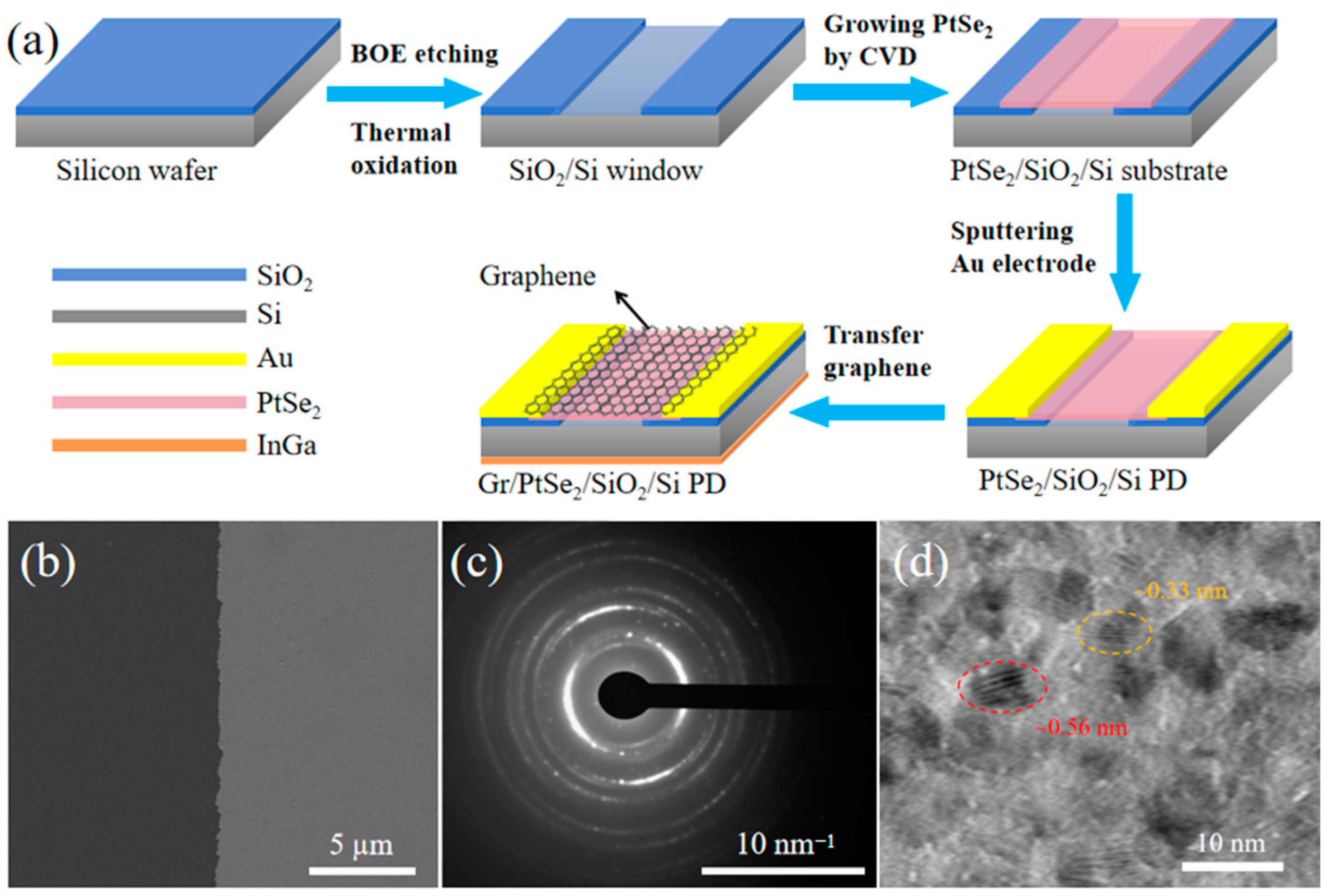
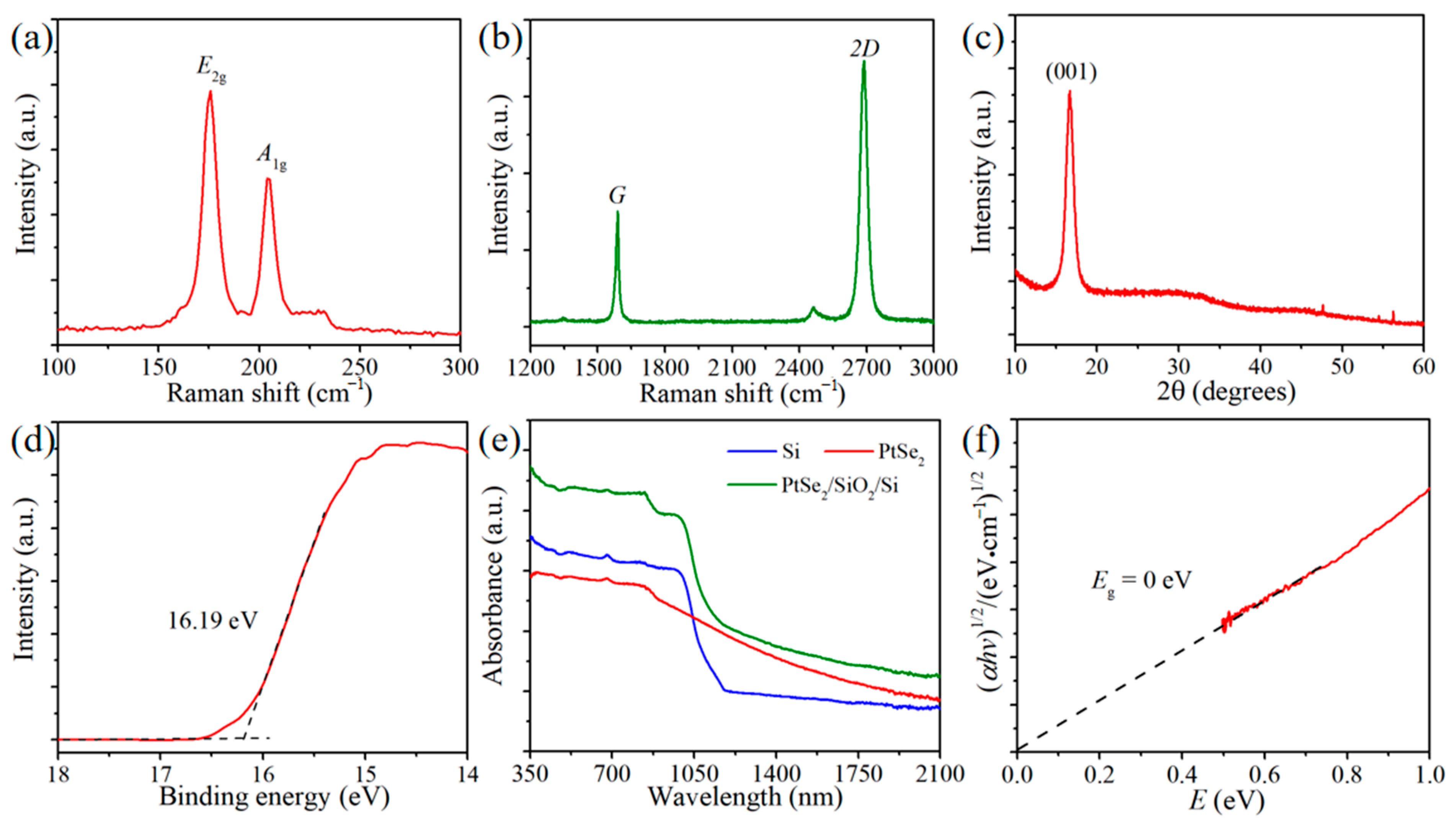
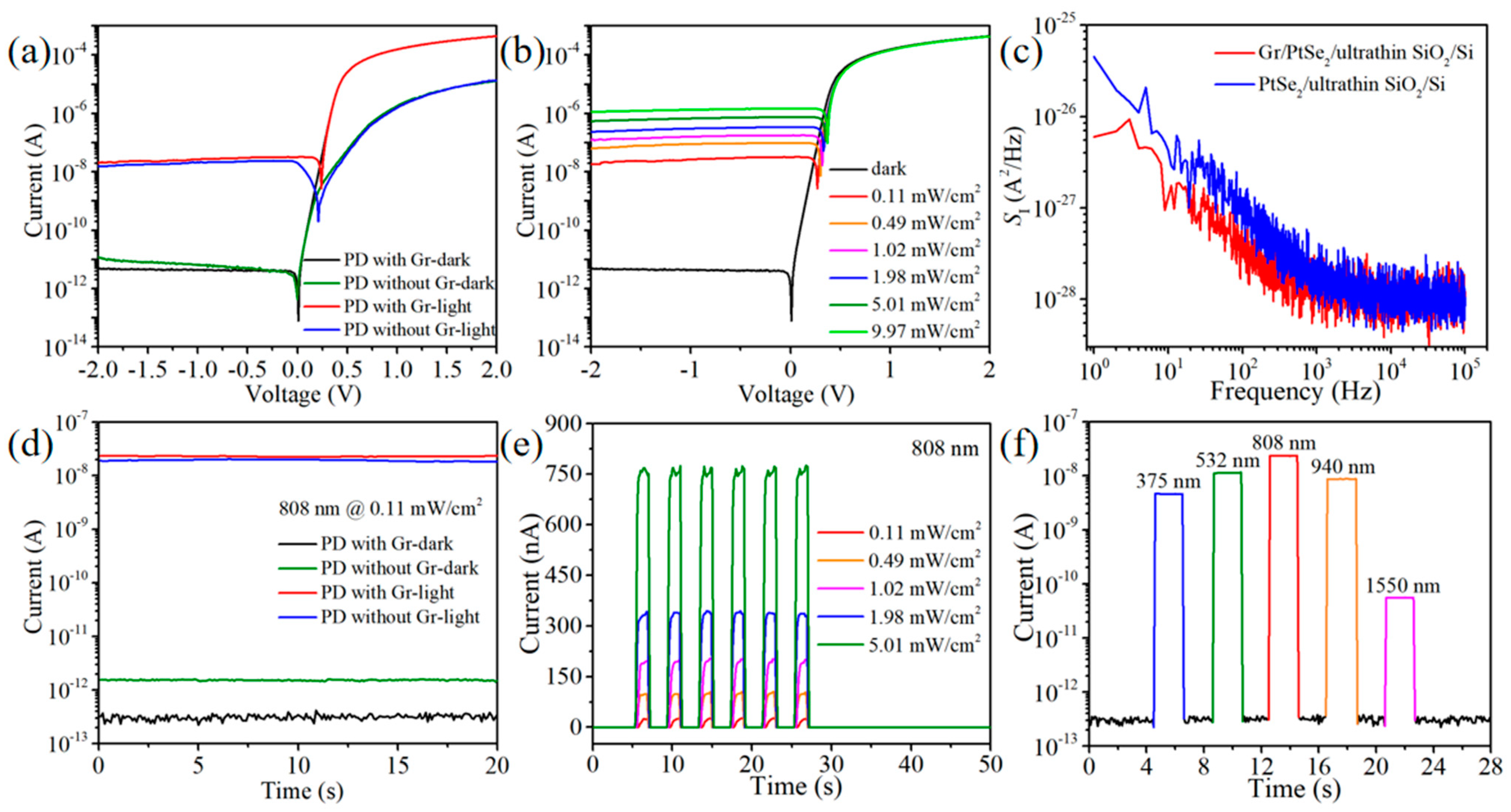
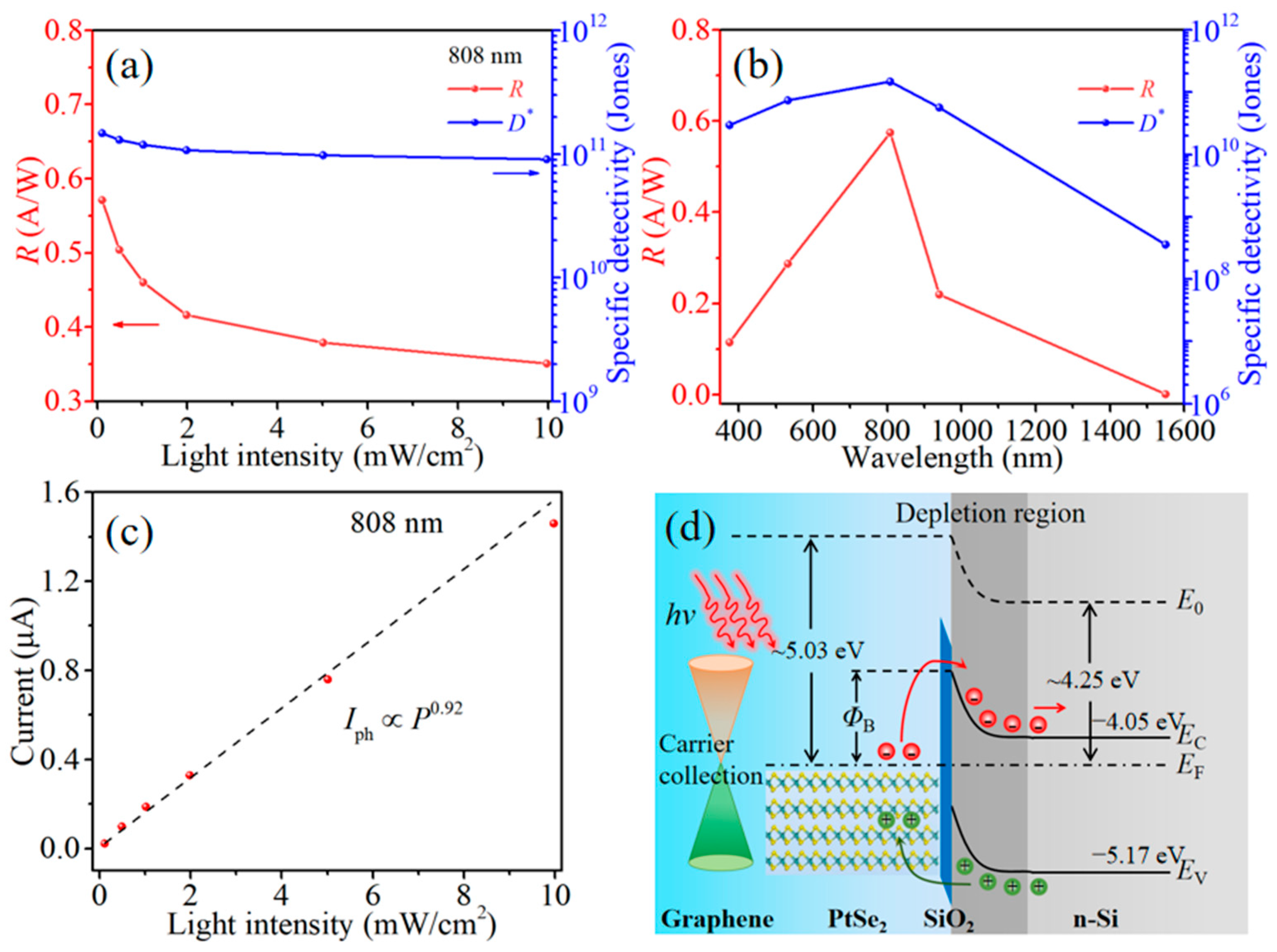
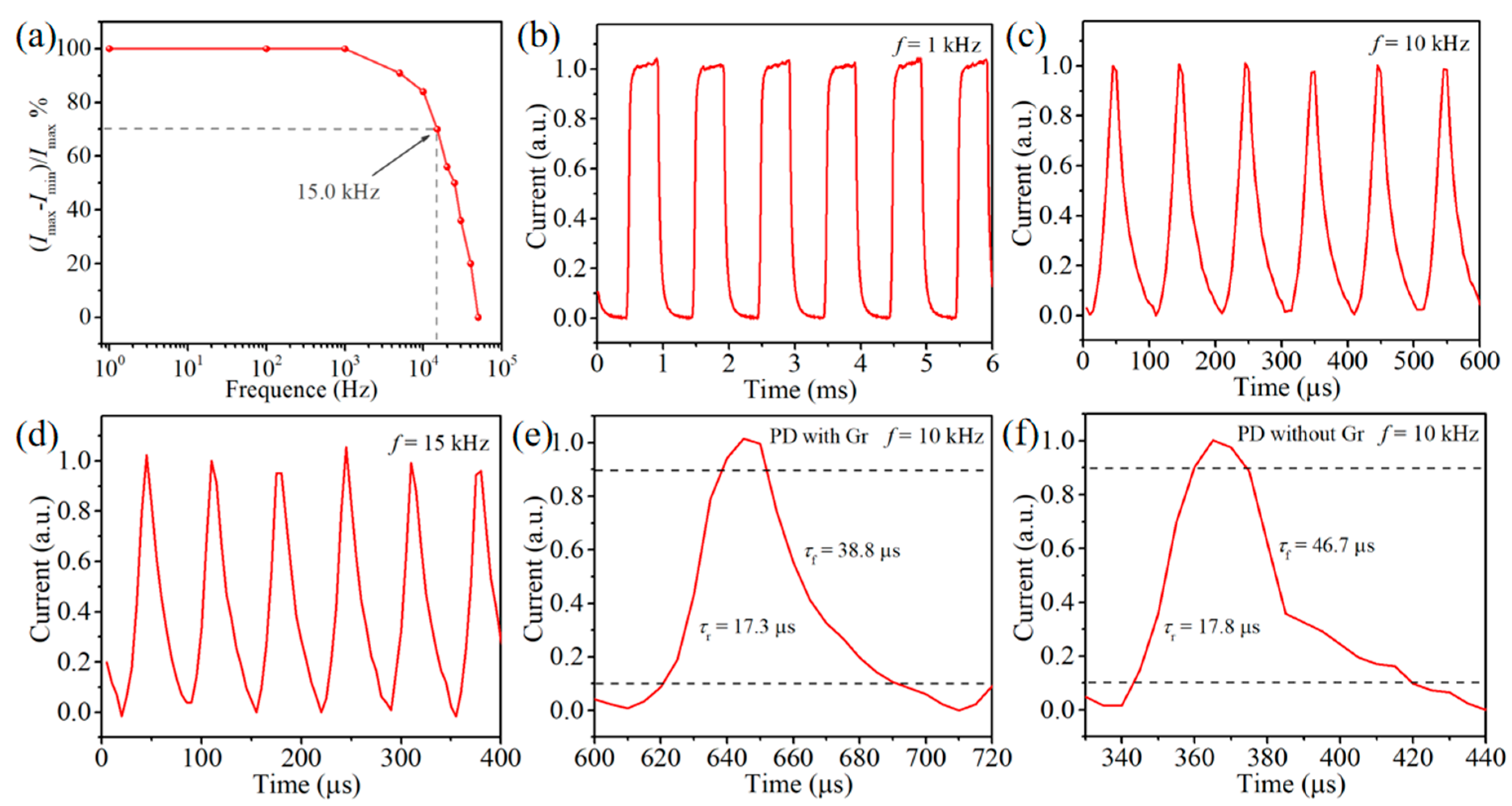

| Devices | λ @ Vbias | R (A/W) | τr/τf | Spectral Range | Ref. |
|---|---|---|---|---|---|
| Si-QD/Gr/Si | 877 nm @ −1 V | 0.495 | / | 300–1000 nm | [56] |
| Gr/Si | 875 nm @ −2 V | 0.435 | ~1.7 ms | 400–900 nm | [57] |
| PtSe2/Si | 808 nm @ 0 V | 0.52 | 55.3/171 μs | 200–1550 nm | [23] |
| Gr/PtSe2/pyramid Si | 980 nm @ 0 V | 0.528 | 8.5/10.2 μs | 980–10,600 nm | [28] |
| Gr/PtTe2/Si | 808 nm @ 0 V | 0.428 | 2.4/32.0 μs | 808–10,600 nm | [58] |
| Gr/PdSe2/Ge | 980 nm @ 0 V | 0.691 | 6.4/92.5 μs | 265–3040 nm | [59] |
| PtSe2/Gr/Si | 808 nm @ −1 V | 0.81 | 43.6/51.2 μs | 375–940 nm | [60] |
| WS2/Si | 980 nm @ 0 V | 0.224 | 16/29 μs | 200–3043 nm | [61] |
| SnSe/Si | 850 nm @ 0 V | 0.567 | 1.6/47.7 μs | 300–1100 nm | [62] |
| WS2/GaAs | 808 nm @ 0 V | 0.527 | 21.8/49.6 μs | 200–1550 nm | [63] |
| PtSe2/ultra-thin SiO2/Si | 808 nm @ 0 V | 0.487 | 17.8/46.7 μs | / | This work |
| Gr/PtSe2/ultra-thin SiO2/Si | 808 nm @ 0 V | 0.572 | 17.3/38.8 μs | 375–1550 nm | This work |
Disclaimer/Publisher’s Note: The statements, opinions and data contained in all publications are solely those of the individual author(s) and contributor(s) and not of MDPI and/or the editor(s). MDPI and/or the editor(s) disclaim responsibility for any injury to people or property resulting from any ideas, methods, instructions or products referred to in the content. |
© 2025 by the authors. Licensee MDPI, Basel, Switzerland. This article is an open access article distributed under the terms and conditions of the Creative Commons Attribution (CC BY) license (https://creativecommons.org/licenses/by/4.0/).
Share and Cite
Zhu, Q.-H.; Chai, J.; Wei, S.-Y.; Sun, J.-B.; Sun, Y.-J.; Kiriya, D.; Xu, M.-S. Graphene/PtSe2/Ultra-Thin SiO2/Si Broadband Photodetector with Large Responsivity and Fast Response Time. Nanomaterials 2025, 15, 519. https://doi.org/10.3390/nano15070519
Zhu Q-H, Chai J, Wei S-Y, Sun J-B, Sun Y-J, Kiriya D, Xu M-S. Graphene/PtSe2/Ultra-Thin SiO2/Si Broadband Photodetector with Large Responsivity and Fast Response Time. Nanomaterials. 2025; 15(7):519. https://doi.org/10.3390/nano15070519
Chicago/Turabian StyleZhu, Qing-Hai, Jian Chai, Shi-Yu Wei, Jia-Bao Sun, Yi-Jun Sun, Daisuke Kiriya, and Ming-Sheng Xu. 2025. "Graphene/PtSe2/Ultra-Thin SiO2/Si Broadband Photodetector with Large Responsivity and Fast Response Time" Nanomaterials 15, no. 7: 519. https://doi.org/10.3390/nano15070519
APA StyleZhu, Q.-H., Chai, J., Wei, S.-Y., Sun, J.-B., Sun, Y.-J., Kiriya, D., & Xu, M.-S. (2025). Graphene/PtSe2/Ultra-Thin SiO2/Si Broadband Photodetector with Large Responsivity and Fast Response Time. Nanomaterials, 15(7), 519. https://doi.org/10.3390/nano15070519






